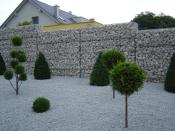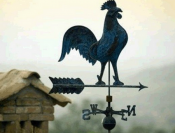Search
Login
Ornamental and medicinal plants on the site. How to grow and keep winter lavender in central Russia
The plant with the romantic name lavender is most likely familiar to us from songs and poems. In fact, the plant deserves the attention of poets: it has a very attractive appearance. A low bush, with a height of 15 to 60 cm, is extremely branched, crowned with light green leaves. During flowering, and it lasts throughout July-August, the plant is covered with numerous inflorescences, which can include up to 10 small flowers. The whole plant, and especially the flowers, exudes a very delicate and delicate aroma. Flowering fields look impressive, especially if they are located on the mountain slopes.
Content
- Where lavender grows video
- How to grow lavender - preparing the soil for planting video
- Lavender propagation: cuttings and layering
- Is it possible to grow lavender from seeds
- Basic care rules video
- Lavender in winter - does she need shelter
- Diseases and Pests
- Lavender in garden design, its preparation and use
Where lavender grows

The homeland of lavender is the Mediterranean. In nature, the plant can be found on the southern slopes of the mountains of Greece and Dalmatia, sometimes quite high above sea level. As a decorative landscape gardening plant, lavender is cultivated in the middle lane of Europe. French farmers cultivating fields in the province of Provence are especially fond of it.

Of course, their interest in the plant is caused not only by its beauty - lavender is the raw material for obtaining a valuable product - lavender oil. It is obtained by steam distillation, the scale of oil production is quite serious - about 50 tons of it are extracted during the season, and about 1200 tons of lavender are produced annually. As a medicinal plant, Europeans use a broad-leaved variety of plants.
She loves to grow in a well-warmed and lit space, this fact should be taken into account when growing lavender in the Moscow region and central Russia. It is best for her to divert areas protected from the north wind, illuminated by the sun. But in this way it will be impossible to achieve the creation of ideal conditions for the plant.
How to grow lavender - preparing the soil for planting

There are no special requirements for soil fertility in the area - in the wild, lavender grows on poor, carbonate soils. However, the plant does not like swampy soil, with a high level of groundwater or those that stagnate when snow melts.
- To create good conditions for planted lavender seedlings, you should equip a high-quality drainage system on the site.
- If the soil on the site has an increased acidity, lime will be required.
- It is not recommended to plant lavender seedlings on heavy, clay soil - wintering a plant in such conditions can be difficult.
Lavender propagation: cuttings and layering

In the industrial cultivation of lavender and when growing it as a decorative plant, vegetative propagation is most often used. This allows you to fully preserve the performance of the plant by the capacity of valuable oils and maintain its decorative properties at a high level.
In the south, autumn cuttings are used. Lignified annual shoots are suitable for him. Cuttings are cut in late autumn and planted in unheated greenhouses. By the fall of next year, quality seedlings will grow from cuttings.
In more severe conditions, for example, in the middle lane or Moscow region, only green cuttings will be successful; they are carried out in June-July. The length of the cuttings is about 10 cm. The lower leaves are removed from them, the lower cut is dipped with a rooting solution, then they are planted thick enough in a greenhouse or in pots.
For planting cuttings, a mixture of peat and sand or turf and wood shavings is prepared. You should not keep the planted cuttings in direct sunlight, they need to shade, in hot weather, spray several times a day with water. Watering should be done carefully - excessive humidity can lead to decay of the cuttings. If planting and caring for lavender are done correctly, approximately 90% of the cuttings can take root. One and a half to two months will be enough for root formation.

For the winter, seedlings are left in greenhouses, those that are rooted in pots are also planted in the ground. An important point - it is necessary to plant with a well-developed root system, but not very late - they must take root in the ground, otherwise they will not be able to withstand freezing of the soil. Experts recommend making green cuttings as early as possible - only it can guarantee the successful propagation of the plant.
To accelerate the process of spring development of the mother bush, it is necessary, after establishing plus temperatures, to pour warm water on it, mulch the soil around the bush with peat, and irrigate the soil with Epin's solution. If the days and nights are cool, they cover the bush with agrofiber. Of fertilizers, you can use humate and ammonium nitrate, not more than once a week. Knowing how to care for lavender correctly, you can get the material for cuttings in June, in early August it will be ready for planting in the ground.
Before the predicted frosts, the soil around the seedlings is mulched. Sometimes they practice wintering of seedlings in pots in the basement or on the insulated balcony. You should harvest seedlings with a margin - with any method of wintering, there may be slight loss from exposure to low temperatures. Lavender is planted in the spring, already at the place of its constant growth.
If the garden already has adult bushes, then you can resort to reproduction by layering. To do this, branches closer to the ground are attached to the ground with brackets, the place of touch is sprinkled with soil, covered with plastic wrap or agrofibre. You can cut a branch from a bush after the appearance of roots and new shoots on it. After making sure that the process has adapted, it can be transplanted to a place of constant habitat.
Is it possible to grow lavender from seeds
Lavender seedlings can also be grown from seeds. Especially they can be useful if all the plants on the site could not survive the winter. Buying lavender seeds is not difficult, they are in almost all specialized gardening stores.

It should be remembered that fresh seeds will not please especially friendly seedlings; for sowing, it is better to take seeds stored for one to two years. Fresh seeds should be stratified for a month at low positive temperatures. It is most convenient to use a refrigerator for this: the seeds are placed in sand, kept in the refrigerator for 30 days, then sown in soil. If you repick seedlings, it will be more active in growth and resistance to disease. Seedlings are fertilized with complex fertilizer once every ten days.
Since lavender is a perennial plant, the soil before planting seedlings should be fertilized with compost or manure in the amount of 10 kg per 1 square meter. Based on the same area, potassium salt (20 g) and superphosphate (50 g) are added.
Basic care rules
We already mentioned above where to plant lavender, and now let’s remember how to plant it. The distance between plants should be no less than 0.5 m and no more than 1 m. Moreover, the farther north the site is, the denser the plants should be planted - their size decreases to the north. Planted lavender is abundantly watered.

Subsequent care is loosening and weeding. Systematic top dressing with mineral fertilizers and diluted bird droppings or mullein will give the plant a decorative look and ensure its active flowering. But it is advisable to produce top dressing only in the first half of summer - an excess of nitrogen fertilizers will not allow the plant to stop the vegetation in a timely manner and prepare for wintering.
Lavender in winter - does she need shelter
Experts say that lavender does not need shelter, even if it grows in central Russia. A shelter made from leaves and peat can lead to the plants growing wet. Even a thick layer of snow, which stays on the ground for a long time in relatively warm weather, can damage.
Do not forget that in spring the plant needs early pruning. The reason is that it belongs to the evergreen, with the onset of heat, the green leaves actively evaporate moisture, the roots that are in the still not thawed soil cannot renew it. Plants suffer greatly from dehydration. Reducing the number of leaves during pruning will reduce evaporation. It is not bad, if possible, to ensure rapid thawing of the soil.
Diseases and Pests

Fortunately, the invasion of pests on the bush is rare. Its main enemies are slobbering pennies and cicadas. Measures to combat them are very simple - you just need to wash off the insects with water from the hose flowing under pressure. Rainbow beetles settled on lavender are best hand-picked. The appearance of a large number of beetles can cause the death of the plant.
With increased dampness of the soil, plants can appear damaged by gray rot. All diseased branches should be removed and burned - the disease tends to spread rapidly to nearby bushes.
Lavender in garden design, its preparation and use

The decorative properties of the plant attract the attention of gardeners - the shrub is used to create mixborders, it looks great as a border. Single flowering plants will decorate the site, in addition, they will fill the garden with a unique fresh aroma.

Flowering lavender begins in the second year of life. You can collect flowers in the second week of flowering. Dry them in a well-shaded area. It is not advisable to use a dryer - intensive drying will result in the loss of valuable oils. Dried flowers are kept in cotton bags.

Lavender bags in cabinets and pantries will help get rid of moths, fungi and bacteria. Does not like her aroma of garden aphids.
Use lavender oil and a lavender decoction in the treatment of acne and other inflammatory skin diseases. Tea brewed from dried flowers will relieve insomnia and improve the condition of a patient with heart neurosis.

Infusion of flowers has diuretic and choleretic properties, will reduce bloating. A warm bath with oil or an infusion of plant flowers has a calming effect on the nervous system, and improves blood circulation.





